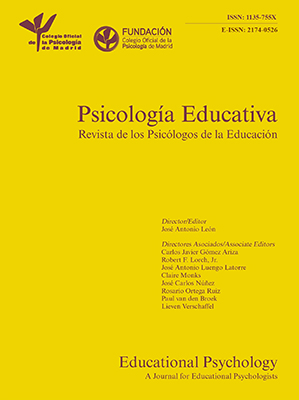
AnÃĄlisis de la RelaciÃģn entre la VictimizaciÃģn y la Violencia Escolar: El Rol de la ReputaciÃģn antisocial
[Analysis of the Relationship Between Victimization and School Violence: The Role of Antisocial Reputation]
EstÃĐvez, EstefanÃa InglÃĐs, CÃĄndido J. Emler, Nicholas P. MartÃnez-Monteagudo, MarÃa C. Torregrosa, MarÃa S.
https://doi.org/10.5093/in2012v21n1a3
Resumen
Estudios previos han identificado dos subgrupos de vÃctimas de violencia escolar. Un primer subgrupo lo componen la mayorÃa de vÃctimas que se caracterizan por su respuesta pasiva y sumisa ante los ataques, mientras que un menor porcentaje, aunque en mayor riesgo de desajuste psicosocial, combina la victimizaciÃģn con un comportamiento desafiante, hostil y agresivo. El presente estudio se centra en el segundo caso, con el objeto de analizar los posibles factores influyentes en el proceso de transiciÃģn de la victimizaciÃģn a la implicaciÃģn en conductas agresivas en el contexto escolar. La premisa de partida se fundamenta en la teorÃa propuesta originalmente por Emler, que sostiene que la percepciÃģn de desprotecciÃģn de la vÃctima en la situaciÃģn de intimidaciÃģn, puede resultar en la bÚsqueda de una reputaciÃģn antisocial que le ayude a auto-defenderse ante futuros ataques, una imagen social que se configura precisamente con la implicaciÃģn en actos violentos. Para analizar estas relaciones, se utilizÃģ una muestra de 1795 adolescentes de entre 11 y 18 aÃąos, escolarizados en nueve centros de educaciÃģn secundaria obligatoria. Para el anÃĄlisis de los datos, se calculÃģ un modelo de ecuaciones estructurales que confirmÃģ la hipÃģtesis de partida.
Abstract
Previous studies have identified two subgroups of victims of school violence. A first subgroup is composed of the majority of victims who are characterized by their passive response and withdrawal in violent situations, while a lower percentage, although at more risk of psychosocial maladjustment, combines victimization with a defiant, hostile and aggressive behaviour. The present study is focused on the second case, with the purpose of analyzing the possible factors influencing the transition from passive victimization to involvement in aggressive behaviors within the school context. The starting premise is based on the theory originally proposed by Emler, which posits that the victimâs perception of helplessness in situations of intimidation, may result in the searching of an antisocial reputation that helps victims defend themselves against future attacks; a social image that takes shape precisely through the involvement in violent acts. To test these relationships, 1795 adolescents between 11 and 18 years of age were recruited from nine secondary schools. To analyse the data, a structural equation model was calculated, which confirmed the starting hypothesis.
Palabras clave
Keywords
Copyright © 2025. Colegio Oficial de la Psicología de Madrid








 CrossRef
CrossRef






